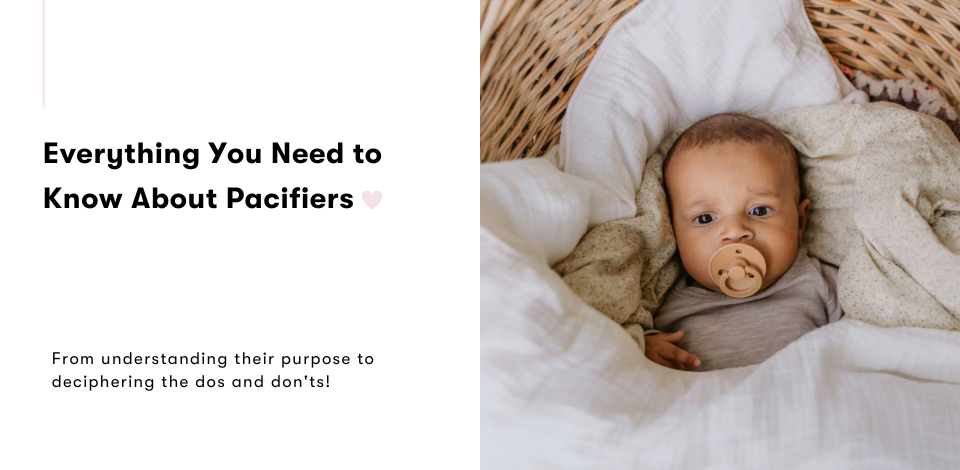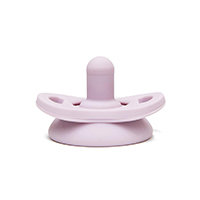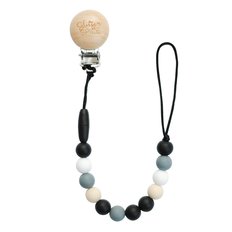Everything You Need to Know About Pacifiers
Aller à la section

Pacifiers are a beloved tool that have provided comfort to babies for generations. While these handy little objects can be useful in keeping your little one calm and collected, navigating the world of pacifiers can be a little confusing.
From understanding their purpose to deciphering the dos and don'ts, there's a lot to consider! To help keep things simple, we have created a guide to give you the lowdown on everything you need to know about pacifiers, so you can make an informed decision for your little one.
Q & A
What is the purpose of a pacifier?
Pacifiers serve a dual purpose: they provide non-nutritive sucking, which can be soothing for babies, and they can also help reduce the risk of Sudden Infant Death Syndrome (SIDS). Sucking is a natural reflex for infants, and pacifiers offer a safe way to satisfy this need
Is it necessary for babies to use a pacifier?
No, pacifier use is not necessary for all babies. Some infants prefer to suck on their fingers or hands instead, while others may not have a strong sucking urge. It's a personal choice for parents and there's no right or wrong answer.
Do pediatricians recommend pacifiers?
Many pediatricians recommend offering a pacifier to babies, especially during sleep times, as it has been shown to reduce the risk of SIDS. However, it's important to follow safe pacifier practices and wean your baby off the pacifier by the age of 2 to 4 years to prevent potential dental issues.
What are the benefits of pacifiers?
Pacifiers offer several benefits, including:
- Soothing and calming effect for babies
- Reduced risk of SIDS
- Temporary distraction or relief for pain or discomfort
- Promoting self-soothing skills
Are there any risks to using a pacifier?
While pacifiers are generally safe when used correctly, there are some potential risks to be aware of, such as:
- Increased risk of ear infections (if used excessively)
- Dental issues (if used beyond the recommended age)
- Nipple confusion for breastfed babies (though research is mixed on this)
If you have any specific concerns, it's always best to discuss them with your healthcare provider.
Are pacifiers okay for breast-fed babies?
Many experts believe pacifiers are safe for breast-fed babies, as long as breastfeeding is well-established (usually around four to six weeks). However, some parents worry that introducing a pacifier too early may cause nipple confusion or interfere with their baby's ability to latch properly. It's generally recommended to wait until breastfeeding is going smoothly before introducing a pacifier.
How to get your baby to take a pacifier?
Getting a baby to accept a pacifier can be tricky, but here are some tips:
- Try offering the pacifier when your baby is calm and content, rather than when they're already fussing or crying.
- Gently rub the pacifier on your baby's cheek or lips to encourage them to open their mouth.
- Try different shapes and materials to find one your baby prefers.
- Be patient and consistent — it may take some time for your baby to get used to the pacifier.
When should a child stop using a pacifier?
Experts have varying opinions on when to wean a child off a pacifier, but most recommend doing so by the age of 2 to 4 years. Prolonged pacifier use beyond this age can potentially lead to dental issues or speech development problems. However, every child is different, and some may be ready to give up the pacifier earlier or later than others.
Do’s And Don’ts Of Pacifier Use
Here’s a list of what you should and should not do when using a pacifier with your child.
Do's:
- Replace pacifiers regularly (every 4 to 6 weeks) or as soon as they show signs of wear and tear.
- Clean pacifiers thoroughly with soap and water or by sterilizing them.
- Offer a pacifier during nap times and bedtime to help reduce the risk of SIDS.
- Let your baby decide when they're ready to give up the pacifier — don't force it.
- Have a designated pacifier storage area or container to keep them clean.
Don'ts:
- Don't force a pacifier on your baby if they resist it — let them choose if they want it or not.
- Don't dip pacifiers in sweet substances like honey or sugar, as this can lead to tooth decay.
- Don't share pacifiers between babies, as this can spread germs and illnesses.
- Don't use a pacifier with decorative attachments or clips, as these can pose a choking hazard.
- Don't let your child walk around or play with a pacifier in their mouth, as this increases the risk of falls and accidents.
For more tips on pacifier safety, check out this excellent article on Health Canada’s website.
Pacifier Buying Guide
With endless pacifier variations available, it can be overwhelming to decide which pacifier is best for your baby. However, by considering a few key factors, you can narrow down your search and find the perfect pacifier for your little one's needs.
- Size: Pacifiers are available in different sizes to accommodate your little one's growth. Smaller sizes are designed for newborns up to six months old, while larger sizes cater to older infants aged 6 to 18 months and beyond, ensuring a snug and comfortable fit for their developing mouths.
- Shape: The shape of the pacifier plays a crucial role in your baby's comfort and oral development. Orthodontic pacifiers feature a flat base and a rounded tip, mimicking the shape of a mother's nipple during breastfeeding. This design promotes healthy oral development and reduces the risk of dental issues that can arise from prolonged pacifier use.
- Materials: Pacifiers are typically made from either latex or silicone materials. Latex pacifiers are known for their soft and flexible texture, but some babies may develop allergies to this material. Silicone pacifiers, on the other hand, offer a firmer and more durable option, making them hypoallergenic and a popular choice among parents. Regardless of the material, it's essential to regularly inspect the pacifier for signs of wear and tear and replace it when necessary.
- Ventilation: Some pacifiers feature ventilation holes on the shield, allowing air to circulate and preventing skin irritation. These holes also help minimize saliva buildup, keeping your baby's skin dry and comfortable. If your little one is prone to drooling, look for pacifiers with this ventilation feature for added convenience.
- Safety: Safety should be the top priority when choosing a pacifier. Opt for one-piece designs and ensure the pacifier is the appropriate size to minimize the risk of choking. The pacifier must be securely attached to the shield, with no loose parts that could pose a choking hazard. Additionally, be cautious of pacifiers with decorative attachments or clips, as these can also present a potential choking risk.
Our Favourite Pacifier Brands
BIBS is a Danish brand known for its stylish and eco-friendly baby products, including pacifiers made from natural rubber and silicone. Their pacifiers are designed with a unique butterfly shape that contours to your baby's face for added comfort. For more information, check out our BIBS Pacifier Round-Up article.
Dr. Brown's is a trusted brand that offers a range of pacifiers that are designed to mimic the natural shape and feel of a mother's nipple. Their pacifiers feature a unique vented design that helps prevent air from entering your baby's tummy, reducing discomfort and spit-up.
A leading name in baby products, Philips Avent, boasts high-quality pacifiers you’ll love. Their orthodontic pacifiers are designed to support healthy oral development, while their soothie pacifiers are perfect for newborns with their soft, flexible design.
Swedish brand Natursutten is dedicated to creating natural and eco-friendly pacifiers made from pure natural rubber. Their pacifiers are free from harmful chemicals and their unique shape is designed to promote healthy jaw development.
Finally, don't forget to keep your pacifier clean with handy accessories like this Silicone Pacifier Holder or Paci Braid Pacifier Clip. These nifty items help prevent your baby's pacifier from getting lost or dirty, ensuring a safe and hygienic experience!
Pacifier Perfection
Navigating the world of pacifiers can be a journey, but with the right knowledge and guidance, you'll find the perfect one for your little bundle of joy. Remember, every baby is unique, and it may take some trial and error to discover their preferences. Embrace the process and don't hesitate to seek advice from your healthcare provider or other trusted sources. With a little patience and the right pacifier, you'll be well on your way to soothing your baby and creating a calming routine that works for your family.
DISCLAIMER; This article is not meant to replace professional medical advice. Always consult with your doctor first should you have any questions or concerns.










